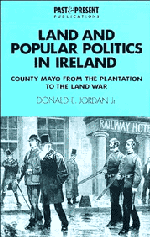Book contents
- Frontmatter
- Contents
- List of figures
- List of maps
- List of tables
- Acknowledgments
- List of abbreviations
- Introduction
- PART 1 COUNTY MAYO PRIOR TO THE FAMINE
- PART 2 THE POST-FAMINE TRANSFORMATION OF COUNTY MAYO
- PART 3 THE LAND WAR IN COUNTY MAYO
- 1 Mayo evictions: explanation of calculations and sources for Table 4.1 and Figure 4.1
- 2 Occupations of suspected Fenians, County Mayo, as recorded in police files, 1866-71
- 3 List of persons whose arrest is recommended under the Protection of Persons and Property Act, 1881, County Mayo
- 4 Explanation of categories and list of Land League meetings for Map 5.2 and Table 3.1
- Bibliography
- Index
- Past and Present Publications
Introduction
Published online by Cambridge University Press: 03 May 2011
- Frontmatter
- Contents
- List of figures
- List of maps
- List of tables
- Acknowledgments
- List of abbreviations
- Introduction
- PART 1 COUNTY MAYO PRIOR TO THE FAMINE
- PART 2 THE POST-FAMINE TRANSFORMATION OF COUNTY MAYO
- PART 3 THE LAND WAR IN COUNTY MAYO
- 1 Mayo evictions: explanation of calculations and sources for Table 4.1 and Figure 4.1
- 2 Occupations of suspected Fenians, County Mayo, as recorded in police files, 1866-71
- 3 List of persons whose arrest is recommended under the Protection of Persons and Property Act, 1881, County Mayo
- 4 Explanation of categories and list of Land League meetings for Map 5.2 and Table 3.1
- Bibliography
- Index
- Past and Present Publications
Summary
During the last quarter of the nineteenth century Ireland was convulsed by three periods of agrarian agitation, which together form one of the most important protest movements in recent European history. The first phase began in 1879, when economic crisis brought on by a confluence of bad weather, meager harvests and low prices undermined the post-Famine prosperity of larger farmers while devastating the fragile economies of the smaller farmers. The Land War quickly spread from the West of Ireland, where it began, into the East and South, until by the winter of 1880–1 the Irish National Land League could boast of hundreds of branches comprising over 200,000 members. At its head was Charles Stewart Parnell, who managed to harness the agitation into the service of a revitalized Irish parliamentary party, in the process propelling himself into the leadership of the party at Westminster. An active party in parliament, supported by a massive agitation in Ireland, forced the Liberal government of William Ewart Gladstone to act on the Irish land question. Although the resulting Land Bill of 1881 fell far short of abolishing landlordism in Ireland, the ultimate goal of the land movement, it corrected some of the most glaring abuses of landlord power, established land courts to arbitrate rent disputes, and laid the foundation for the transfer of land ownership from landlords to working farmers.
- Type
- Chapter
- Information
- Land and Popular Politics in IrelandCounty Mayo from the Plantation to the Land War, pp. 1 - 10Publisher: Cambridge University PressPrint publication year: 1994

